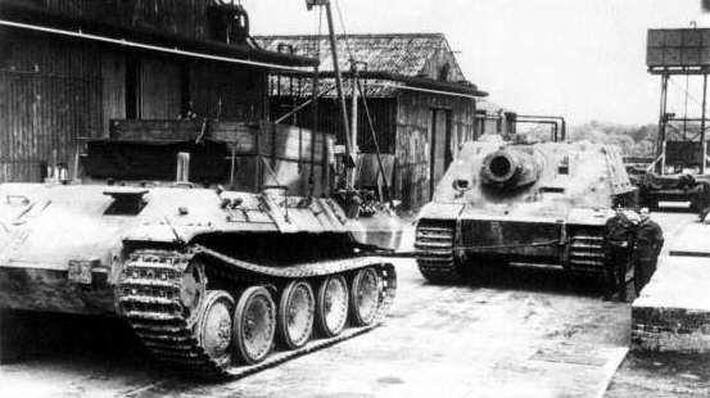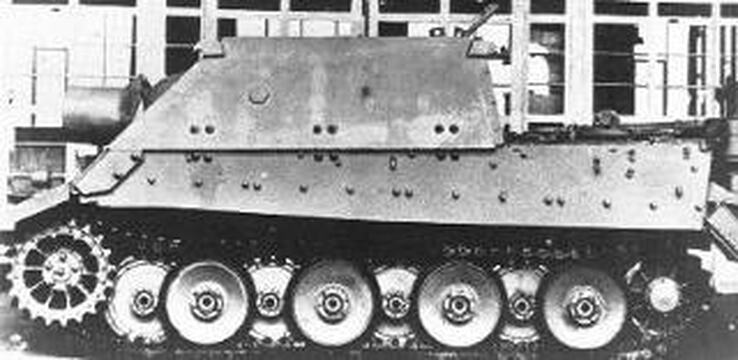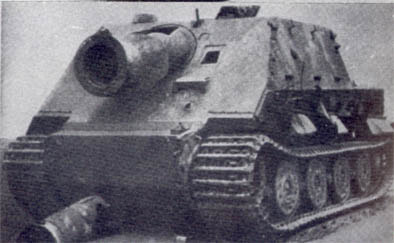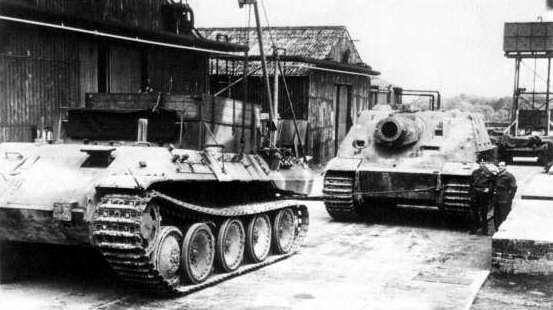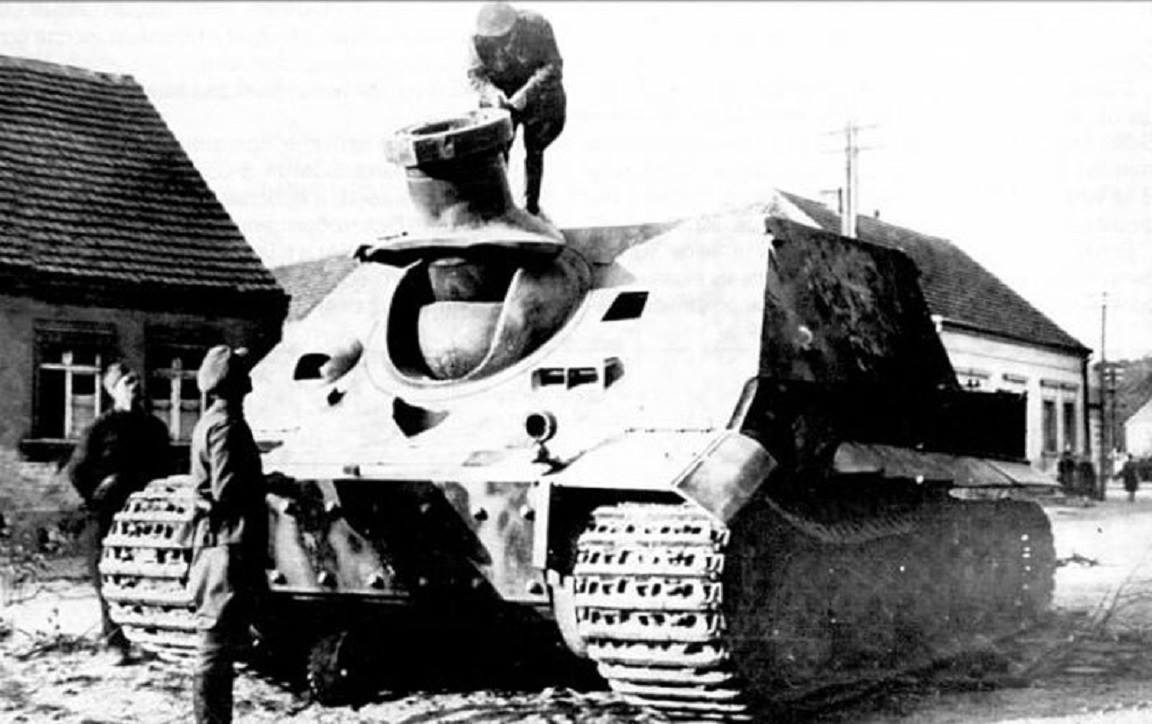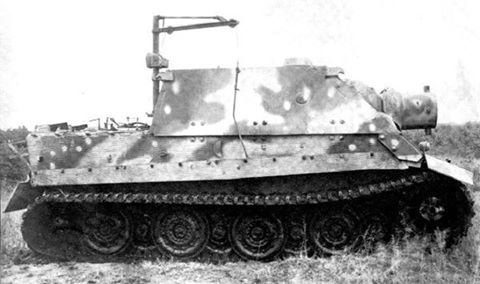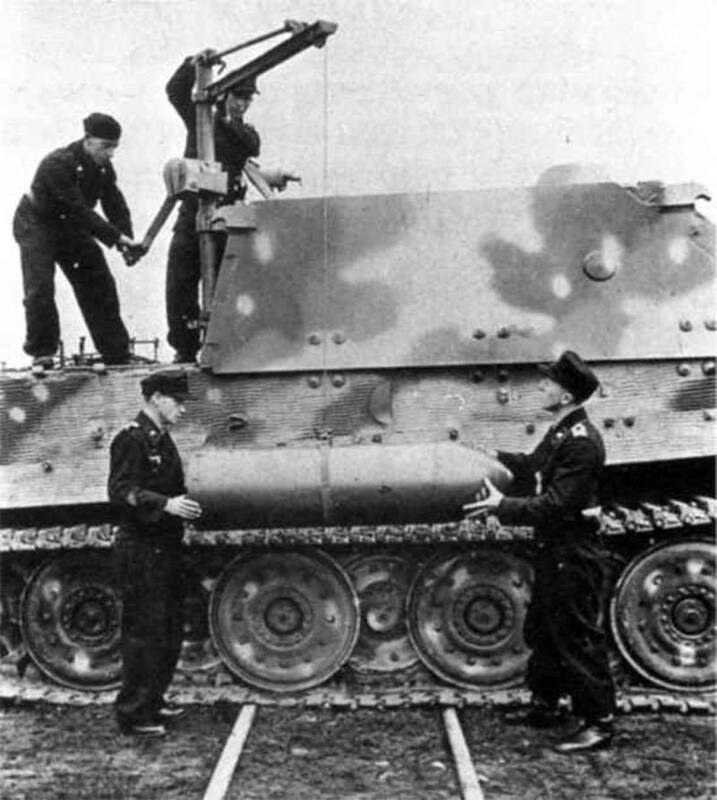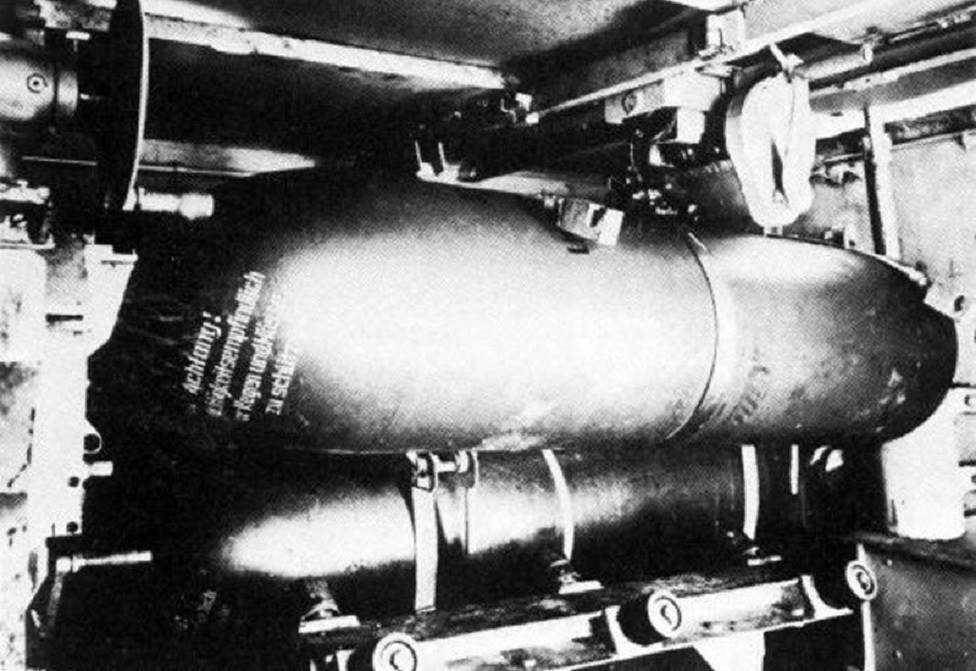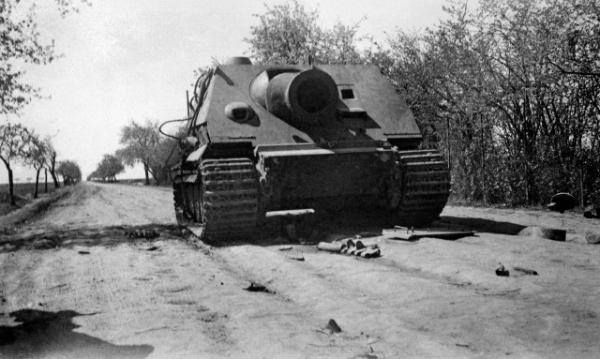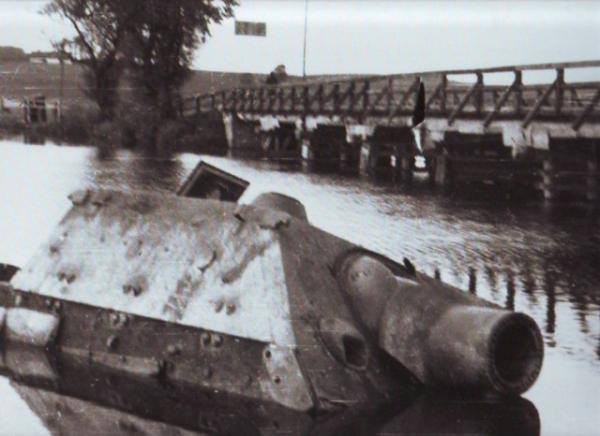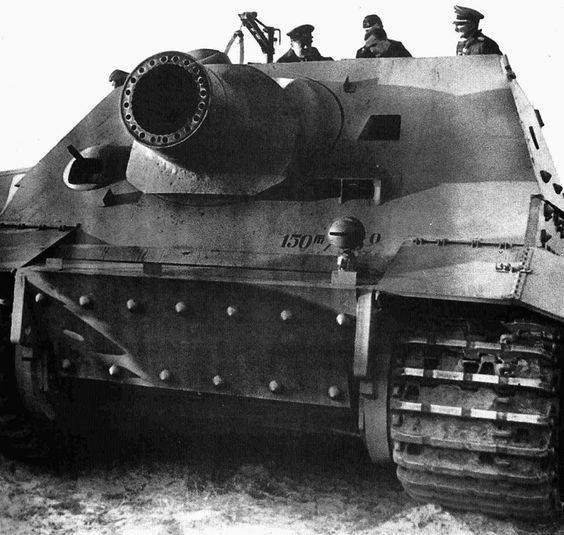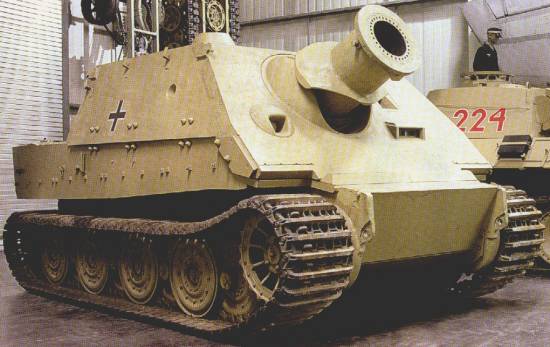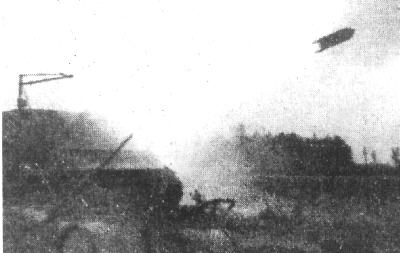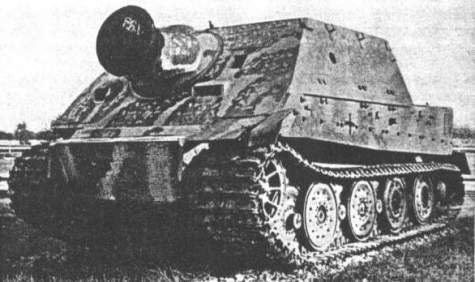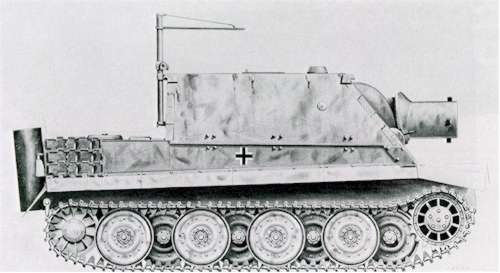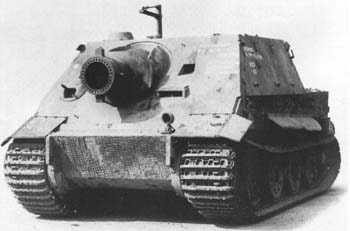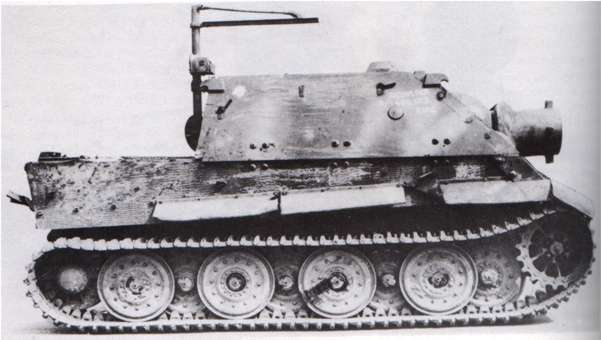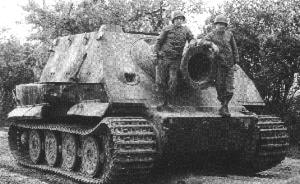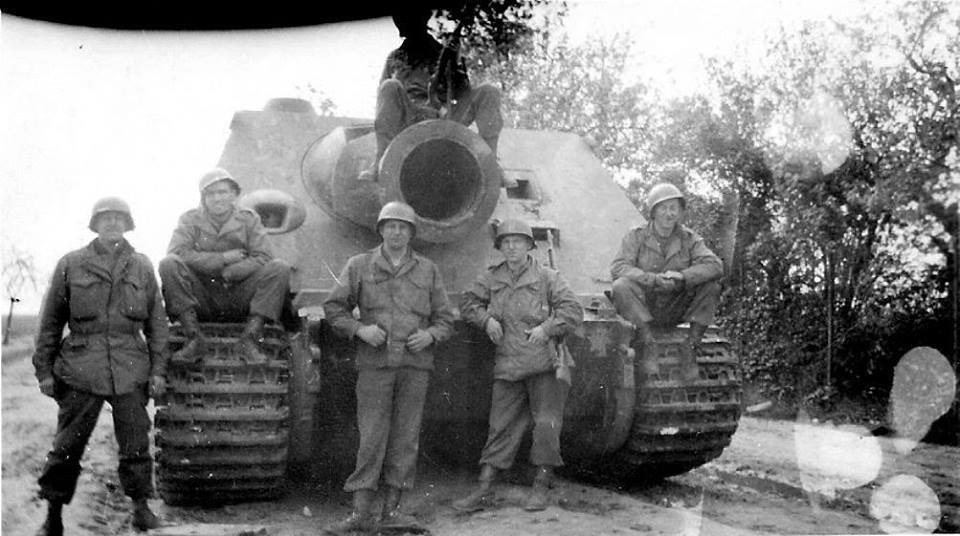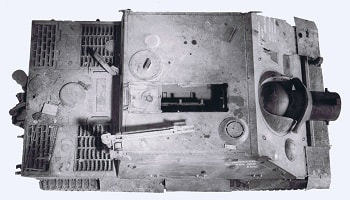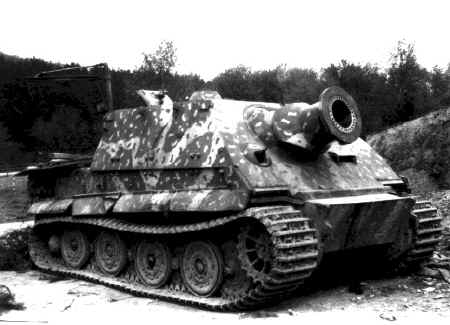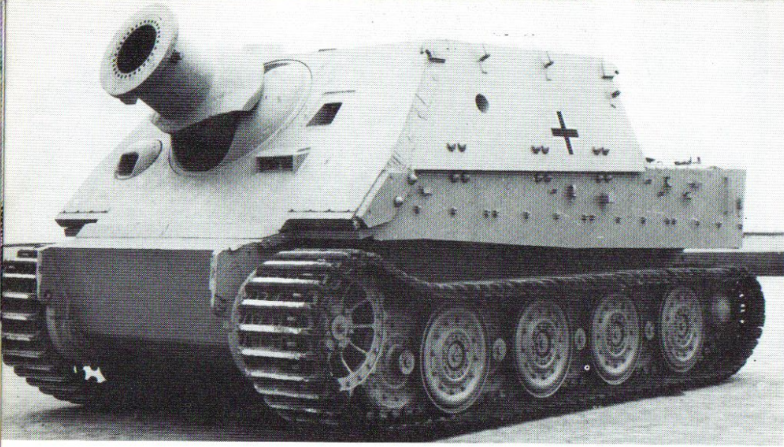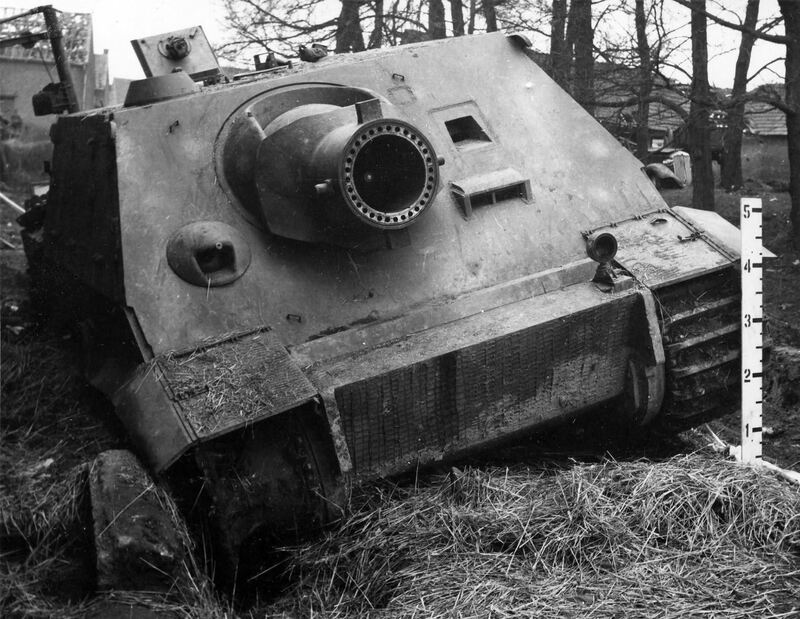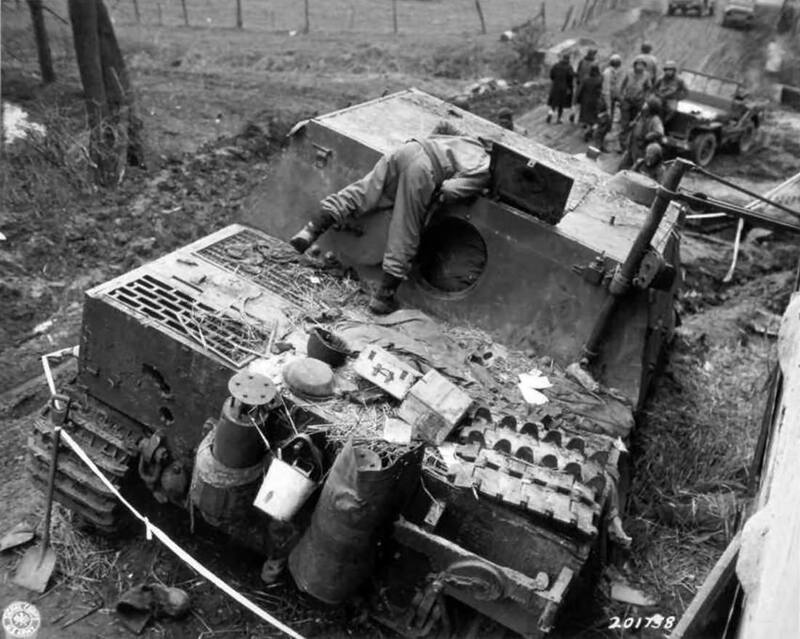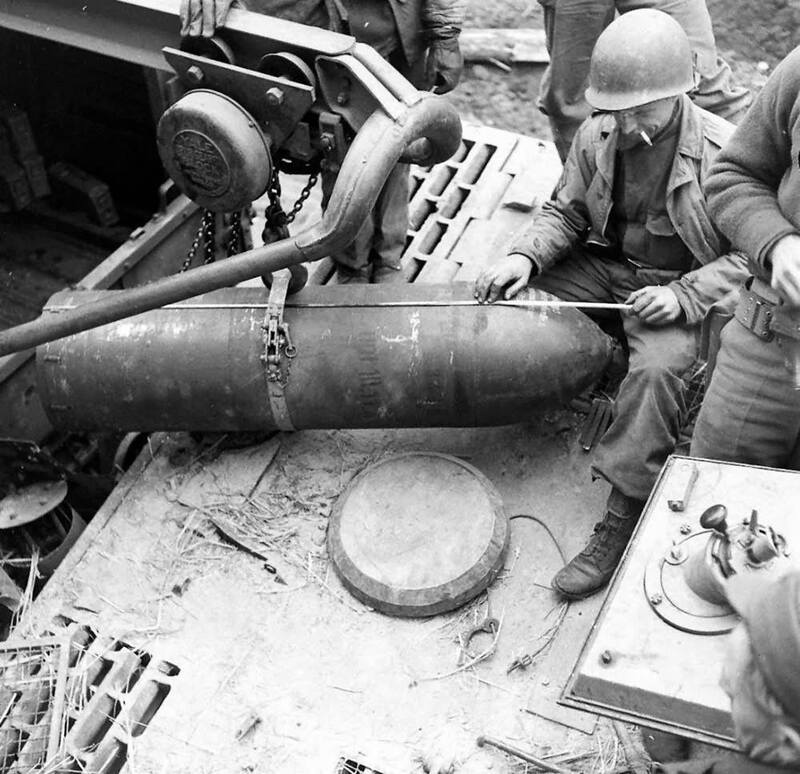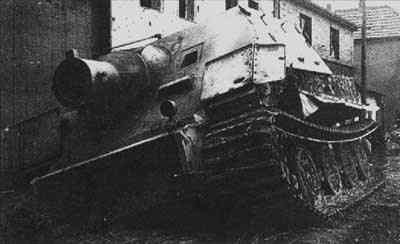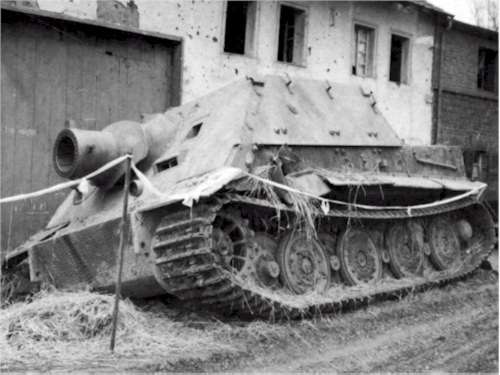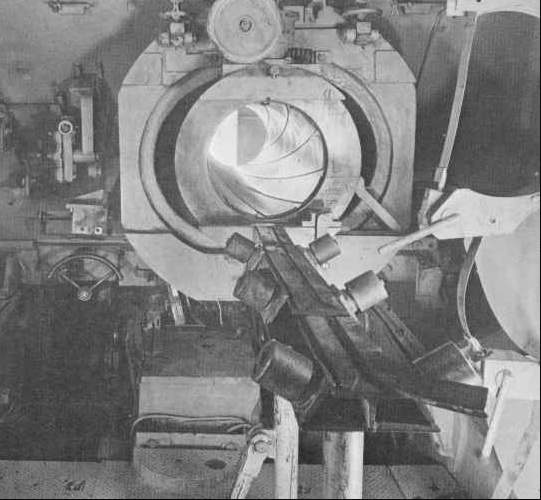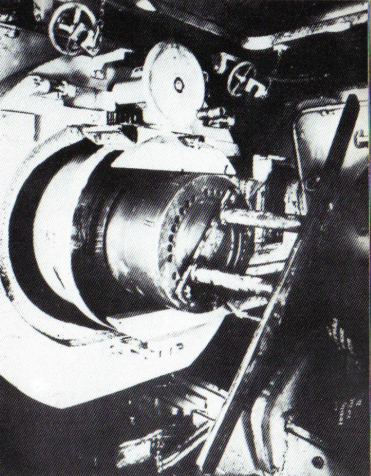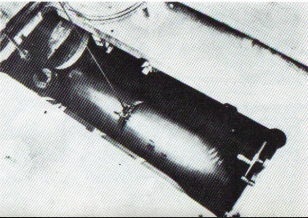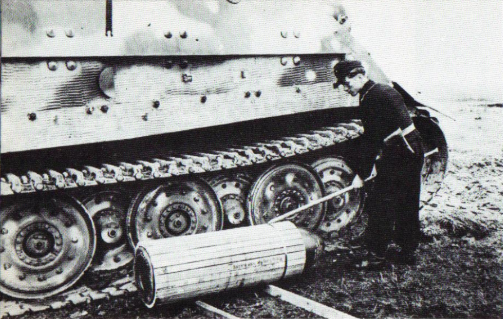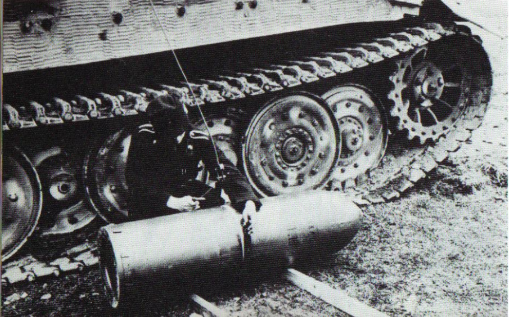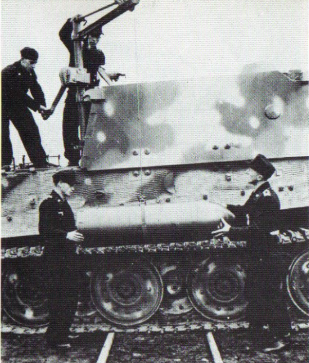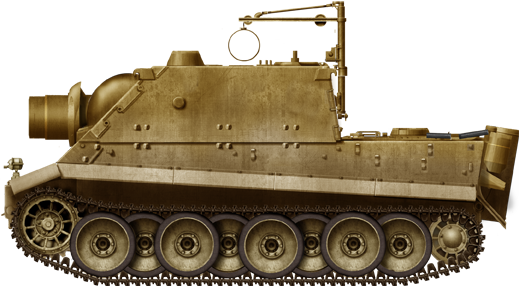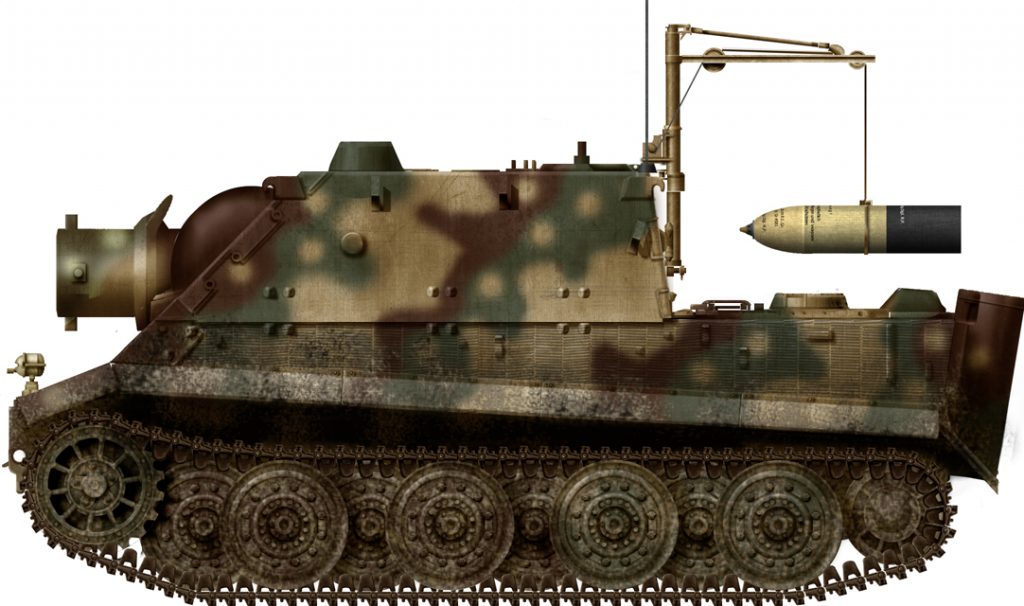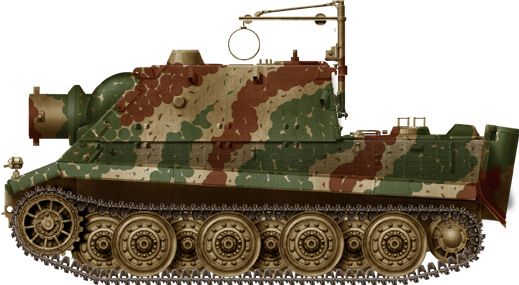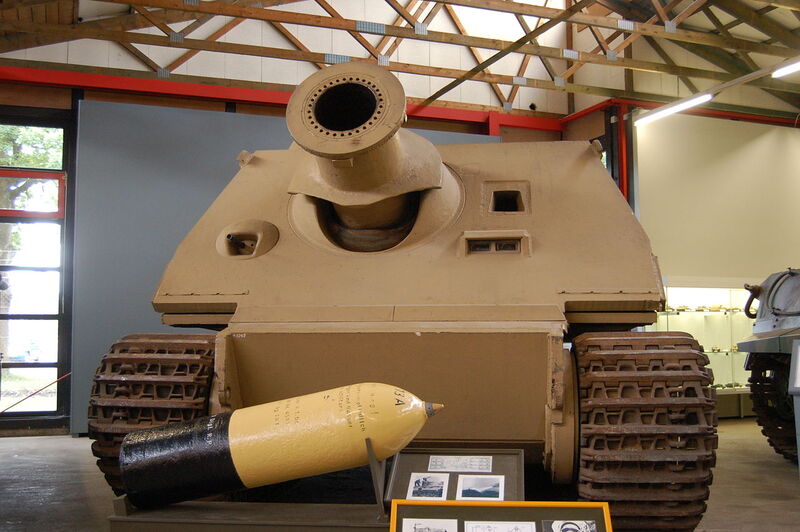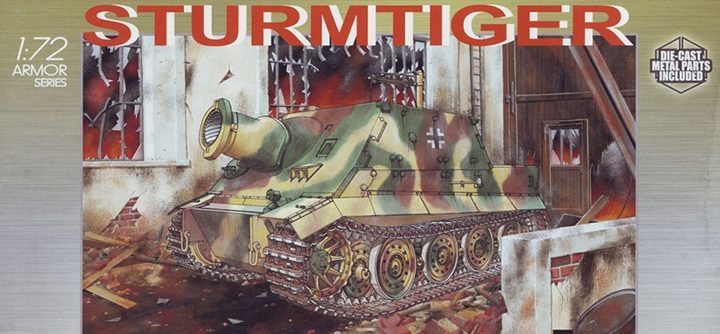Sturmtiger
Aside from the command versions, the Sturmtiger was the only major variant of the Tiger I to see production.
In the early May of 1942, the new design of a Sturmpanzer Bär armed with 305mm L/16 gun mounted in the superstructure and utilizing a Tiger I chassis was created but never materialized. In Autumn of 1942, under the influence of heavy fighting in Stalingrad, the concept of heavy infantry support vehicle was revived.
Production of such a weapon was not ordered until 5th August 1943 by Hitler. Designed as a short-range heavy assault weapon to aid in city fighting, it arrived too late to participate in the offensive campaigns. It was suggested to mount the 38cm RTg launcher that was being developed for the navy by Rheinmetall-Borsig onto a tank chassis and used as an assault weapon. On August 5th of 1943, it was decided to mount modified Tiger with 380mm heavy mortar. It was originally intended to arm Sturmtiger with 210mm howitzer which was not available at the time.
The recoil was around 40 tons so the Tiger I chassis was selected. The first prototype was developed by Alkett and was shown to Hitler on October 20, 1943 at Arys, East Prussia. It took about 10 minutes to load the 761 lb. shell. There was a crane that was used to help load the rounds into the vehicle. The range was around 5,900 meters. It's consumed fuel at the rate of 2 gallons per mile.
Eighteen vehicles were converted from August to December of 1944 by Alkett at their Berlin/Spandau factory. Owing to the urgency placed on the project by Hitler, each conversion required an average of only three days.
Chassis
The chassis from the Tiger I with steel rimmed wheels were used for the Sturmtiger. A special superstructure was constructed for the gun and crew of five. That superstructure had frontal armour of 150mm, sides and rear 80mm, the chassis front 100mm, side 60mm and rear 80mm. The complete vehicle weighed 65 tons, had a length of 6.28m, a width of 3.57m, a height of 2.85m and had a Maybach HL230P45 motor with 650 PS, which allowed a maximum speed of 40km/h.
Superstructure
The heavily armored superstructure was manufactured by Brandenburger Eisenwerke while hull conversion was done by Alkett in their at their Berlin-Spandau plant.
Armament
The primary armament of the Sturmtiger was a short-barrelled 38cm Raketenwerfer RW61 L/5.4 and a MG34 in the front plate. This weapon had been originally designed for the German Navy by Rheinmetall Borsig for use in anti-submarine warfare. Each projectile combined a Treibsatz 4581 rocket motor with a high explosive or hollow charge (HEAT) cap. Each round weighed 726 lb. (330 kg) and was over 5 feet long (1.52 m). The crane located on the superstructure rear was used in loading these massive projectiles through an apeture in the roof. Perhaps the most unique feature of the mortar is the means of exit for the rocket exhaust gasses from the projectile. The rocket gasses could not be allowed into the fighting compartment, so they were routed through an armored jacket surrounding the barrel with numerous exit holes surrounding the muzzle.
The Sturmtiger could carry 14 rounds of the rocket assisted explosive shell 4581. These had a weight of 345kg, a length of 1489mm and had 125kg explosives inside. When firing there was a recoil energy of 30 tons. After leaving the gun barrel the rocket motor accelerated with 40kg of rocket powder to 250m/s. That gave a firing range of about 5650m. Only 317 of such grenades reached the troops. 1945 a hollow charge grenade was projected with the number 4592, which could penetrate 2.5m of steel-concrete.
In the early May of 1942, the new design of a Sturmpanzer Bär armed with 305mm L/16 gun mounted in the superstructure and utilizing a Tiger I chassis was created but never materialized. In Autumn of 1942, under the influence of heavy fighting in Stalingrad, the concept of heavy infantry support vehicle was revived.
Production of such a weapon was not ordered until 5th August 1943 by Hitler. Designed as a short-range heavy assault weapon to aid in city fighting, it arrived too late to participate in the offensive campaigns. It was suggested to mount the 38cm RTg launcher that was being developed for the navy by Rheinmetall-Borsig onto a tank chassis and used as an assault weapon. On August 5th of 1943, it was decided to mount modified Tiger with 380mm heavy mortar. It was originally intended to arm Sturmtiger with 210mm howitzer which was not available at the time.
The recoil was around 40 tons so the Tiger I chassis was selected. The first prototype was developed by Alkett and was shown to Hitler on October 20, 1943 at Arys, East Prussia. It took about 10 minutes to load the 761 lb. shell. There was a crane that was used to help load the rounds into the vehicle. The range was around 5,900 meters. It's consumed fuel at the rate of 2 gallons per mile.
Eighteen vehicles were converted from August to December of 1944 by Alkett at their Berlin/Spandau factory. Owing to the urgency placed on the project by Hitler, each conversion required an average of only three days.
Chassis
The chassis from the Tiger I with steel rimmed wheels were used for the Sturmtiger. A special superstructure was constructed for the gun and crew of five. That superstructure had frontal armour of 150mm, sides and rear 80mm, the chassis front 100mm, side 60mm and rear 80mm. The complete vehicle weighed 65 tons, had a length of 6.28m, a width of 3.57m, a height of 2.85m and had a Maybach HL230P45 motor with 650 PS, which allowed a maximum speed of 40km/h.
Superstructure
The heavily armored superstructure was manufactured by Brandenburger Eisenwerke while hull conversion was done by Alkett in their at their Berlin-Spandau plant.
Armament
The primary armament of the Sturmtiger was a short-barrelled 38cm Raketenwerfer RW61 L/5.4 and a MG34 in the front plate. This weapon had been originally designed for the German Navy by Rheinmetall Borsig for use in anti-submarine warfare. Each projectile combined a Treibsatz 4581 rocket motor with a high explosive or hollow charge (HEAT) cap. Each round weighed 726 lb. (330 kg) and was over 5 feet long (1.52 m). The crane located on the superstructure rear was used in loading these massive projectiles through an apeture in the roof. Perhaps the most unique feature of the mortar is the means of exit for the rocket exhaust gasses from the projectile. The rocket gasses could not be allowed into the fighting compartment, so they were routed through an armored jacket surrounding the barrel with numerous exit holes surrounding the muzzle.
The Sturmtiger could carry 14 rounds of the rocket assisted explosive shell 4581. These had a weight of 345kg, a length of 1489mm and had 125kg explosives inside. When firing there was a recoil energy of 30 tons. After leaving the gun barrel the rocket motor accelerated with 40kg of rocket powder to 250m/s. That gave a firing range of about 5650m. Only 317 of such grenades reached the troops. 1945 a hollow charge grenade was projected with the number 4592, which could penetrate 2.5m of steel-concrete.
Operational History
Alkett was order to produce the first prototype by early October of 1943. On October 20th of 1943, first prototype Sturmtiger was presented to Adolf Hitler at the training facilities at Arys. This prototype had iron armor plates and was put to the extensive testing and was eventually approved for production. It was then finally decided to start the production and to utilize retired or battle damaged Tigers (late model) instead of newly built ones.
The Prototype Sturmtiger was then transported on August 12th of 1944 to Pruszkow and next day was moved to Warsaw to take part in the German attempt to contain the Polish Home Army's Uprising. This Sturmtiger saw action in Starowka and Mokotow districts of Warsaw.
On August 28th, after successful debut, it was brought back to Alkett plant in Berlin-Spandau. In the early September of 1944, newly formed PzStuMrKp 1000, equipped with two Sturmtigers arrived in Warsaw. From August to December 1944, Alkett completed only 18 Sturmtigers which equipped four Panzer Sturmmorser Kompanies (PzStuMrKp) - 1000, 1001, 1002 and 1003 which served on the Western Front. Some took part in the Ardennes Offensive, while most of them took part in the defensive battles along the River Rhine. Sturmtigers proved be an excellent defensive weapon and had to be either destroyed by a heavy artillery bombardment or an air attack. It is reported that once single shot fired by Sturmtiger from PzStuMrKp 1001 completly destroyed three M4 Shermans.
Alkett was order to produce the first prototype by early October of 1943. On October 20th of 1943, first prototype Sturmtiger was presented to Adolf Hitler at the training facilities at Arys. This prototype had iron armor plates and was put to the extensive testing and was eventually approved for production. It was then finally decided to start the production and to utilize retired or battle damaged Tigers (late model) instead of newly built ones.
The Prototype Sturmtiger was then transported on August 12th of 1944 to Pruszkow and next day was moved to Warsaw to take part in the German attempt to contain the Polish Home Army's Uprising. This Sturmtiger saw action in Starowka and Mokotow districts of Warsaw.
On August 28th, after successful debut, it was brought back to Alkett plant in Berlin-Spandau. In the early September of 1944, newly formed PzStuMrKp 1000, equipped with two Sturmtigers arrived in Warsaw. From August to December 1944, Alkett completed only 18 Sturmtigers which equipped four Panzer Sturmmorser Kompanies (PzStuMrKp) - 1000, 1001, 1002 and 1003 which served on the Western Front. Some took part in the Ardennes Offensive, while most of them took part in the defensive battles along the River Rhine. Sturmtigers proved be an excellent defensive weapon and had to be either destroyed by a heavy artillery bombardment or an air attack. It is reported that once single shot fired by Sturmtiger from PzStuMrKp 1001 completly destroyed three M4 Shermans.
|
10 were used in the East with first action August 1944.
Three companies were formed, the 1000, 1001, 1002. On 11.October 1944 the assault mortar detachment 1001 got the first 4 Sturmtiger. Also the assault mortar detachments 1002 and 1003 got Sturmtigers of which 13 were available in early March 1945. The 1000 and 1001 were used in the Ardennes offensive with 4 tanks each. Company 1001 saw action in western Eifel. In March 1945 their last action was east of Bonn. Company 1002 saw action in the Reichswald area. In March 1945 they moved to Rheinberg. |
See Also:PzStuMrKp 1000
PzStuMrKp 1001 PzStuMrKp 1002 ?PzStuMrKp 1003 |
Prototype Sturmtiger
On 20th October 1943 Alkett delivered a Prototype, which was demonstrated on the training area Arys. The prototype, was running on the normal rubber tyred wheels of the Tiger E.
Production Sturmtigers
Sturm-Morser Batterie 1001
Sturmtiger of Sturm-Mörser-Batterie 1001, captured by 117th Infantry Regiment troops after it was abandoned by the german crew, in Oberembt March 1945.
38cm Raketenwerfer RW61 L/5.4
Colour Schemes
The Museums Display Piece:
Other Resources:
References
- Encyclopedia of German Tanks of World War two, Chamberlain, Doyle, Jentz, 1993, Arms and Armour Press
- Waffen und Geheimwaffen des deutschen Heeres 1933-1945, Hahn, 1998, Bernard & Graefe
- Panzer-Kampfwagen Tiger und seine Abarten, Spielberger, 1994, Motorbuch
- Panzerkampfwagen Tiger in der Truppe, Fleischer, 1998, Podzun-Pallas
- Tanks Encyclopedia
- Encyclopedia of German Tanks of World War two, Chamberlain, Doyle, Jentz, 1993, Arms and Armour Press
- Waffen und Geheimwaffen des deutschen Heeres 1933-1945, Hahn, 1998, Bernard & Graefe
- Panzer-Kampfwagen Tiger und seine Abarten, Spielberger, 1994, Motorbuch
- Panzerkampfwagen Tiger in der Truppe, Fleischer, 1998, Podzun-Pallas
- Tanks Encyclopedia

